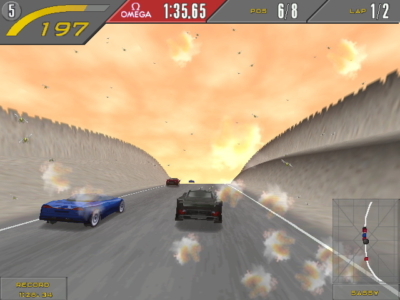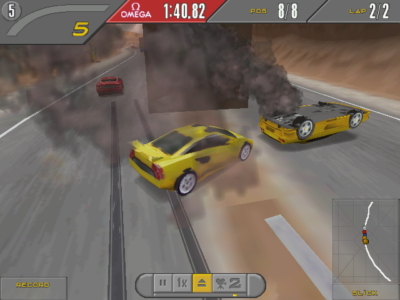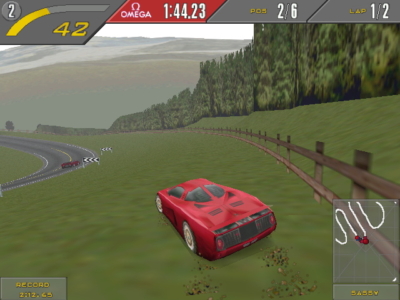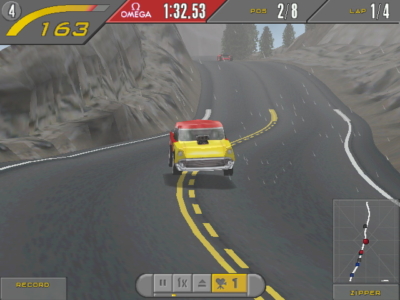
Need for Speed II: Special Edition
Written by: Rik
Date posted: September 2, 2021
- Genre: Racing
- Developed by: Electronic Arts
- Published by: Electronic Arts
- Year released: 1997
- Our score: 4
Regular readers, if any exist, will know that we are aware of our failings when it comes to reviewing a series of games in a linear, chronological (some might say, ‘correct’) order. But, even by our standards, Need for Speed rather takes the biscuit. Ever since the first and third games were among the first racing titles to be reviewed here, this second one has been consistently overlooked, with coverage otherwise continuing in an altogether haphazard fashion, as our brief history shows, although belatedly a concerted effort has been made to fill the gaps.
My long-running excuse for leaving this one out was operating system related, although clearly I didn’t look into things that keenly because there’s evidently been an unofficial patch to fix things up available since 2012 or so. In truth, I was also not particularly excited about revisiting this first sequel, having already given it a wide berth in the late-90s, upon discovering that it did not build on the real roads and police chases of the first game and was instead an altogether less remarkable lap-based racer.
I don’t mind, and can even enjoy, a good lap-based racer, even if it happens to be wearing road trousers, as this one does, in partial acknowledgement of the series’ origins and continuity. But, particularly at the time, it was so disappointing to have two of the most exciting major elements – weaving through traffic at high speed, on what looked like functioning, real-life highways, and evading police pursuers – excised from a follow-up at the first time of asking.
You can have traffic turned on in Need for Speed II, but only in single race mode, and only when head-to-head with a solitary opponent. The same was true of the original The Need for Speed, too, but there the tournament modes felt secondary to the core experience of engaging the AI in a duel across three stages on the open road, while avoiding the attentions of the local highway patrol: a pleasing upgrade on the template provided by Test Drive II: The Duel. Here, though, the civilian cars are an anomaly, driving around and around in circles, just like you.
Hence, single races in NFS II are fairly pointless, except for the purposes of practice, and the main objective is instead to achieve victory in the two available competition modes. The standard Tournament is a fairly straightforward points accumulation scenario, similar to the one offered by the first game, in which you need to complete races across all of the available tracks against a grid of opponents in similarly-powered motors. The class of car (there are three) is pre-set for each race and cannot be changed, and so you’ll need to master and achieve victory in the slowest as well as the fastest category of available vehicles.

Does it make any sense for flies to splat onto the screen and obscure your view while using the chase camera? Write in, you could win a prize.
The other option is Knockout, an altogether more challenging proposition, which involves the ability to choose a single car and class of opponent, and then complete all courses in order of increasing difficulty. The main goal is not to finish last, with the eliminated opponent then removed from an ever-diminishing field for the subsequent race, with ultimate victory accomplished by beating a single opponent on the hardest track.
Courses range from Proving Grounds, a foot-to-the-floor loop, to Mystic Peaks, a snow-based pain in the arse. Success in Knockout mode also allows you to race on, and unlock, a Hollywood-alike bonus track, Monolithic Studios. On the positive side, it could be said that they’re all longer and more varied than those available in the previous game, with the addition of weather effects, while the invisible wall that previously surrounded the road has been widened, with more scope for leaving it without coming to a standstill.
However, there’s also a move away from realistic locations to a slightly more wacky, theme-park-interpretations-of-a-country vibe: one track, exclusive to this slightly later Special Edition release, involves driving through a stone skull into the heart of a volcano. There’s also a recurring theme of rope bridges, some of which you can drive through and plummet to your death, while others remain impenetrable. It’s another step away from The Need for Speed and calls to mind slightly more lightweight racers like Ford Racing 2 (an unfavourable comparison which I apparently already made during coverage of another slightly iffy entry in the series – clearly writing things in the wrong order means that you end up repeating the same points again and again).
Memorable moments of driving pleasure are also fairly rare. There’s a bit on the Pacific Spirit course, a long straight with gentle curves, which can be fun to see how quickly it can be taken, but otherwise it’s a quagmire of sharp corners and unpleasant twistiness, with which the cars seem ill-equipped to cope. Steering and Need for Speed have hardly been happy bedfellows over the course of the series, and from the very first game through to the last (that we’ve covered), its brand of racing has been best enjoyed while accelerating through gaps between civilian cars on a straight bit of road with gentle curves. Every time it puts too much focus on ‘proper’ driving (with the possible exception of Porsche 2000 and SHIFT), things start to fall apart.
Players have the choice of three handling styles. If you choose the simulation option, you should be prepared to brake roughly 10 minutes before each corner before gently sliding into the wall anyway, regardless of the attributes of your chosen 90s sports car, bringing back memories of the fairly rustic handling of the first game. Switch to the arcade setting, and things become a bit more like Need for Speed III, making cornering easier, although this comes at a price by increasing the likelihood of comedy pile-ups caused by idiotic AI racers. Crashes hurt you more than them, which makes it annoying when you get rear-ended through no fault of your own and sent cartwheeling through the air. (The third racing style, ‘Wild’, is exclusive to this special edition, and I couldn’t readily detect much difference from the arcade setting, to be honest).
Having treated this game with casual disregard for so many years led me to think of it – erroneously – as some kind of outlier, with the fairly obvious conclusion that it might represent a middle point of transition between the first and the third NFS titles somehow coming as a surprise. You can definitely see traces of NFS III: Hot Pursuit here, particularly in the instant replay mode, while the leaden handling and chunky car-flip crashes remain from the first game.
The range of available cars is suitably 90s, and includes the obligatory amusing concept vehicles that presumably looked futuristic to people in the past. The Special Edition also includes some additional standard cars from the outset, plus some more zany ‘bonus’ vehicles as reward for performance in either of the tournament modes. Crucially, there is some mileage in weighing up the differences in performance and handling when selecting a car in advance of a tournament. Unfortunately, however, particularly for a niche in-car view enthusiast such as myself, the one in NFS II: SE doesn’t feature dashboards in the 3dfx version, which is a shame. They are present if you just run it in software graphics mode, and there’s even evidence of anecdotal fan preference for the non-accelerated version for this and other reasons, but I couldn’t seem to get that one working and so can’t really comment.
Speaking of which, there are clearly some people out there with fond memories of this one, but for me, other than it being an interesting stepping stone between two other games in the series, and filling in a gap in my knowledge, I can’t say that it has too much to recommend it. As previously noted, it lacks the ambition of the first game, while there doesn’t seem to be anything here that isn’t also done better in the third. So, it’s sadly a case of road trousers out of ten for this one.





 Posts
Posts
“Regular readers, if any exist” : YES !
“Does it make any sense for flies to splat onto the screen and obscure your view while using the chase camera ?” : yes, it does… as for the lenses and flares effects supposed to come from the sun while the driver is driving and not taking photographs with an old Reflex camera ! 😉
Careless programming by bozos too happy to show off they’re able to do it. Another variant of stupid #MeToo.
By the way : “Joyeux anniversaire pour le site et ses administrateurs”, and as the Prisoner has it : “Many Happy Returns” to it and to the both of you, gentlemen.
September 3, 2021 @ 1:20 pm
To counter the argument for the flies against the chase cam: no, it doesn’t.
Prize!
June 26, 2023 @ 12:11 am
P.S. : Useless and irrational lenses and flares effects seen in several racing games. For this NFS, can’t remember but guess this was not the case.
September 3, 2021 @ 1:28 pm